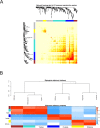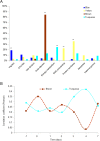Co-expression network analysis identifies gonad- and embryo-associated protein modules in the sentinel species Gammarus fossarum
- PMID: 31133674
- PMCID: PMC6536538
- DOI: 10.1038/s41598-019-44203-5
Co-expression network analysis identifies gonad- and embryo-associated protein modules in the sentinel species Gammarus fossarum
Abstract
Next generation sequencing and mass spectrometry technologies have recently expanded the availability of whole transcriptomes and proteomes beyond classical model organisms in molecular biology, even in absence of an annotated genome. However, the fragmented nature of transcriptomic and proteomic data reduces the ability to interpret the data, notably in non-model organisms. Network-based approaches may help extracting important biological information from -omics datasets. The reproductive cycle of the freshwater crustacean Gammarus fossarum.provides an excellent case study to test the relevance of a network analysis in non-model organisms. Here, we illustrated how the use of a co-expression network analysis (based on Weighted Gene Co-expression Network Analysis algorithm, WGCNA) allowed identifying protein modules whose expression profiles described germ cell maturation and embryonic development in the freshwater crustacean Gammarus fossarum. Proteome datasets included testes, ovaries or embryos samples at different maturation or developmental stages, respectively. We identified an embryonic module correlated with mid-developmental stages corresponding to the organogenesis and it was characterized by enrichment in proteins involved in RNA editing and splicing. An ovarian module was enriched in vitellogenin-like proteins and clottable proteins, confirming the diversity of proteins belonging to the large lipid transfer family involved in oocytes maturations in this freshwater amphipod. Moreover, our results found evidence of a fine-tuned regulation between energy production by glycolysis and actin-myosin-dependent events in G. fossarum spermatogenesis. This study illustrates the importance of applying systems biology approaches to emergent animal models to improve the understanding of the molecular mechanisms regulating important physiological events with ecological relevance.
Conflict of interest statement
The authors declare no competing interests.
Figures





References
-
- Zhang, B. & Horvath, S. A general framework for weighted gene co-expression network analysis. Stat Appl Genet Mol Biol4, Article17 (2005). - PubMed
Publication types
MeSH terms
LinkOut - more resources
Full Text Sources

